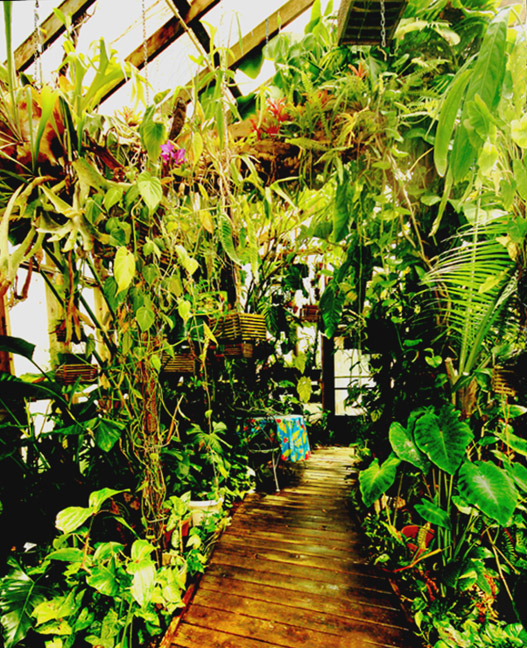![]()
Aroids and other genera in the Collection
Take the Tour Now?
Orchids
The
Exotic Rainforest
The images on this website are copyright protected. Please contact us before any reuse.
Within our collection we have many species of Anthurium.
If you are seeking other photos,
click this link
New:
Understanding, pronouncing and using
Botanical terminology, a Glossary
"Much of what we believe is
based on what we have yet to be taught. Listen to Mother Nature. Her advice
is best."
Growing the Tropical Anthurium
Where
Anthurium live in nature,
Anthurium
care, how to cultivate, grow,
pot and water an
Anthurium including information
how
Anthurium
species grow and reproduce in the
rain forest.
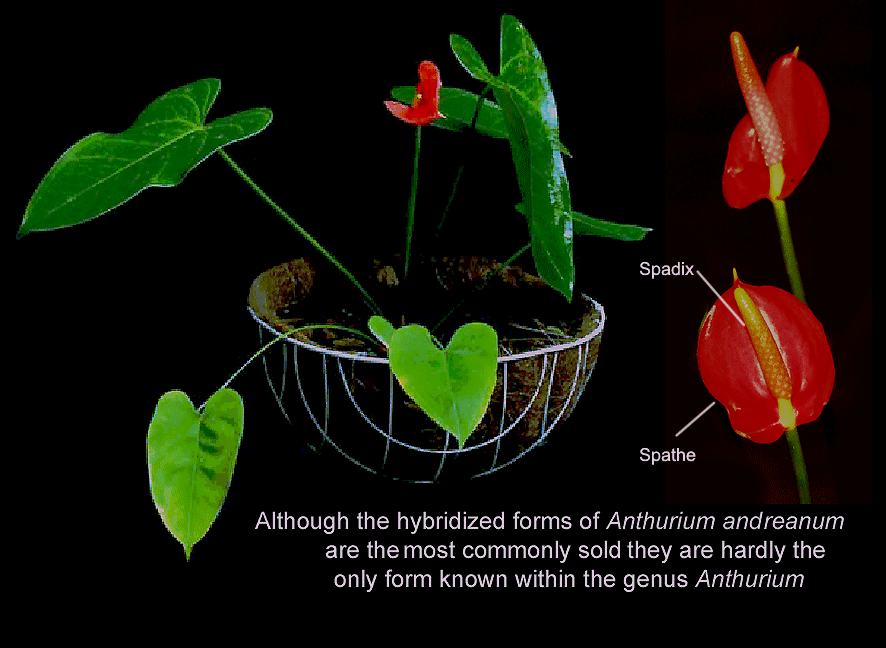
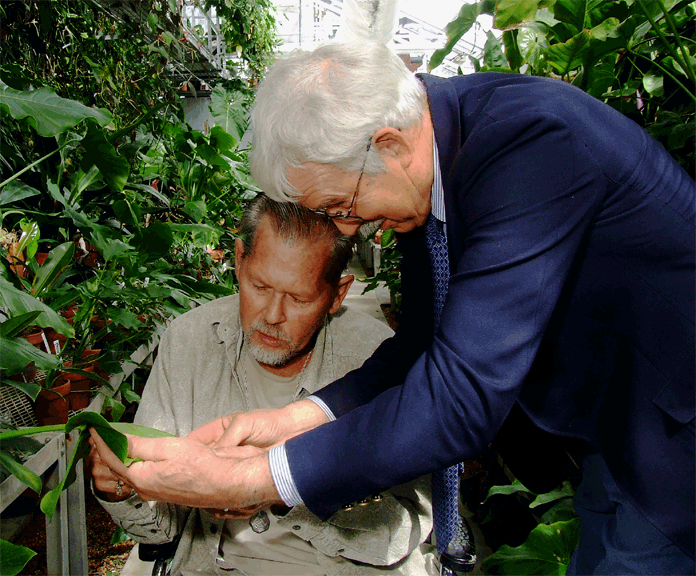 This
text was written and all photography (unless otherwise noted) was
created by Steve Lucas,
www.ExoticRainforest.com
Although
as non-technical as possible
the information on this page is based
largely on the scientific journals
of my teacher and mentor aroid botanist Dr. Thomas B. Croat
Ph.D., P.A. Schulze Curator of Botany
of the Missouri
Botanical Garden in St. Louis, MO.
This
text was written and all photography (unless otherwise noted) was
created by Steve Lucas,
www.ExoticRainforest.com
Although
as non-technical as possible
the information on this page is based
largely on the scientific journals
of my teacher and mentor aroid botanist Dr. Thomas B. Croat
Ph.D., P.A. Schulze Curator of Botany
of the Missouri
Botanical Garden in St. Louis, MO.
Dr. Croat (CROWat)
was honored in
the summer of 2008 for having collected over 100,000 specimens in
the wild. My thanks to aroid expert Julius Boos, aroid, palm
and cycad expert Leland Miyano and expert aroid grower Russ Hammer
for their input into this article. My sincere thanks to
Dr. Croat for his continued guidance as well as frequent personal communication.
The photo below is of our Exotic Rainforest Botanical Garden.
You
can find photographs and information on many of the species in our
collection by clicking on this link:
Species in the ExoticRainforest
Collection.
either as you read or once you find the information you are seeking. An effort has been made to keep
this information non-technical while scientifically accurate.
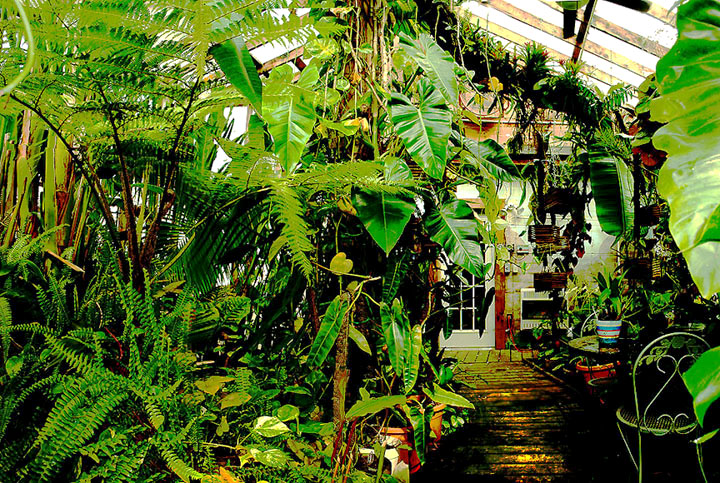 most people grow? Did you know more Anthurium
species live in the rain forests of Central and South America
and more grow in trees than in the soil? Are you aware Anthurium species
sometimes grow with their roots attached only to a stone? Did you know the beautiful growth on your Anthurium
plant most people know as a "Flamingo Flower" or "Flamingo Lily"
is not a flower?
most people grow? Did you know more Anthurium
species live in the rain forests of Central and South America
and more grow in trees than in the soil? Are you aware Anthurium species
sometimes grow with their roots attached only to a stone? Did you know the beautiful growth on your Anthurium
plant most people know as a "Flamingo Flower" or "Flamingo Lily"
is not a flower? Instead of a flower it is more like a "flower holder" since it is a modified leaf or bract known as the spathe of the inflorescence. In botany a bract is a specialized leaf that is associated with the reproductive structure of the plant. The spadix at its center can grow a group of very tiny flowers but most people need a magnifying glass to see them!
Almost every week someone is directed to this website because they do a search for "aquatic Anthurium species". Sorry, there is virtually no such thing! There are species such as Anthurium amnicola and a few others that grow as
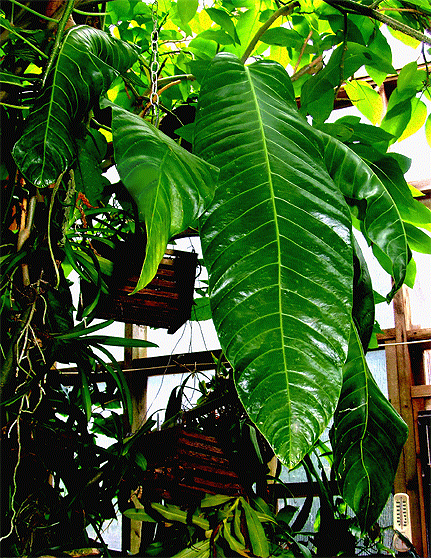 rheophytes or riparians living with their roots attached to moderate
or large stones in streams that have a fast water flow.
Riparian
indicates the plant lives near a creek or the shore of a lake
while a rheophyte is a plant that has adapted itself to grow
either in or on the banks of a fast flowing river.
Botanists often differentiate between a true aquatic plant and a
terrestrial species based on whether or not the species is found
exclusively in water or primarily lives in the soil but may
adapt to living in or near the water.
rheophytes or riparians living with their roots attached to moderate
or large stones in streams that have a fast water flow.
Riparian
indicates the plant lives near a creek or the shore of a lake
while a rheophyte is a plant that has adapted itself to grow
either in or on the banks of a fast flowing river.
Botanists often differentiate between a true aquatic plant and a
terrestrial species based on whether or not the species is found
exclusively in water or primarily lives in the soil but may
adapt to living in or near the water.The downstream side of a rock sitting in water is where the highest spray and humidity is found. If the plant has its roots in the water it would be able to collect highly oxygenated air as a result of the turbulence moving around the rock. The downstream side of the rock is a safer place to exist since the force of the water is much lower as opposed to the upstream side and the plant would suffer less damage while using the rock as a shield. However, the Anthurium is not truly living aquatically in the water since it is attached to the rock near the water's surface. Instead of being aquatic it is a specialized form of lithophyte or rock dweller (litho-FIT) that uses a specialized position in the river or stream to gain both dissolved nutrients as well as a higher source of oxygen.
Despite information on several websites telling you how they believe the name should be spoken, many get it wrong. Some try to tell you to pronounce the genus name "AN-thu-ri-um" or "an-thur-E-um" but those are incorrect. The name is Latin based and is correctly pronounced "an-THOO-re-um".
Popular questions asked on the internet include how do I grow an Anthurium, how do I pot an Anthurium, and how do I grow Anthurium from seeds? Two truly strange questions I've personally been asked many times are "can I grow an Anthurium in water" and "please tell me the names all the aquatic Anthurium species"? According to Dr. Croat (see his credits at the top of this page) there is really no such thing as an aquatic Anthurium although there are rheophytic
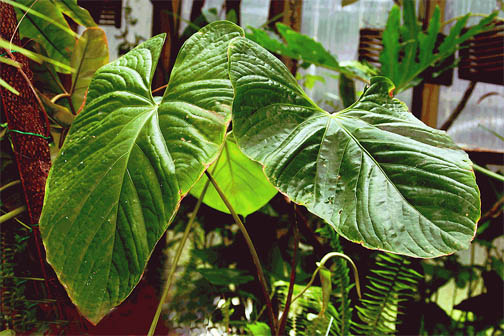 species
that grow attached to rocks in fast moving streams.
species
that grow attached to rocks in fast moving streams.
In nature you may find species
growing near water but no identified species grows rooted in the water
year round. Some grow in water during the middle of the rainy season when the
ground is flooded and are obviously water tolerant. The rainy season does not last all year
and once the flood waters recede the plants
go back to their normal growth. There is one species that
has yet to be described to science located in Peru that does
grow in creeks but it also grows in soil. Species such as
Anthurium sagittatum can live in drainage ditches but this
type of growth is not common. As a result I cannot
recommend trying to grow any garden center Anthurium in
an aquarium or water vase.
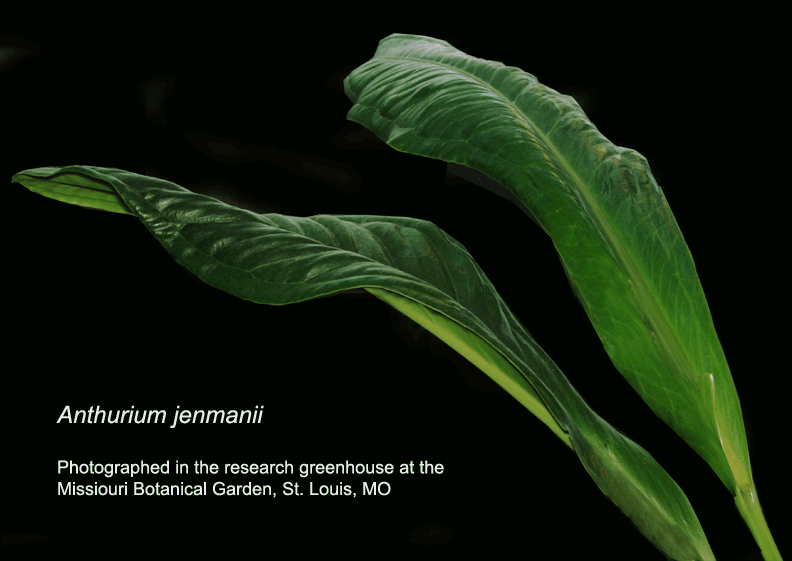 Dr. Croat is recognized as the world's leading
authority on the genus Anthurium. Of modern
experts he has discovered, named and described more species than any other
scientist having
personally collected more than 100,000 plant specimens in the
wild.
Dr. Croat is recognized as the world's leading
authority on the genus Anthurium. Of modern
experts he has discovered, named and described more species than any other
scientist having
personally collected more than 100,000 plant specimens in the
wild.Anthurium species are found throughout southern Mexico, Central America and much of tropical South America with a few species found in the West Indies (Caribbean). The vast majority of the most beautiful forms are located on the western slopes of the Andes Mountains within the rain forests of Ecuador and Colombia. Those species are also widely variable and it is not uncommon for a single species to produce more than one leaf form. You can find an explanation of "variability" here: Natural variability
Despite a number of articles on the internet that claim up to fifty Anthurium species are found in Southeast Asia according to science none are native in that part of the world. One internet "encyclopedia" appears to be the source of this dubious information. Aroid expert Julius Boos explains, "Anthurium is a Neotropical genus and does not occur naturally anywhere outside the Neotropics!" The Neotropics is defined as South and Central America. part of Mexico and the West Indies.
Any Anthurium species found in Asia, the South Pacific, or an Indonesian rain forest would have been introduced by plant collectors. Julius' information is verified in many of the published papers written by Dr. Croat. Plants from the genus Anthurium can be now found on many South Pacific islands but only as an introduced species. In Hawaii many can be found in cultivation since the genus is used to hybridize variations that are commonly sold in garden centers. Anthurium plants are a major export product for the Hawaiian islands but none live naturally in Hawaii. http://www.aroid.org/genera/anthurium/abstrap1.htm
How do Anthurium grow naturally?
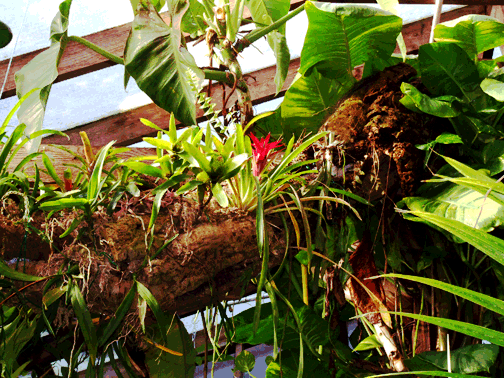 frequent
dampening of the roots but they must also be allowed to dry quickly. An important fact anyone interested in Anthurium species
must understand is only a few Anthurium species grow in
the ground
in the rain forest! The majority grow up on
the sides of trees or up in the canopy well above the ground. Even many of gigantic "birds
nest" forms grow on the limb of a tree not in the soil, but
they can be taught to live in soil!
frequent
dampening of the roots but they must also be allowed to dry quickly. An important fact anyone interested in Anthurium species
must understand is only a few Anthurium species grow in
the ground
in the rain forest! The majority grow up on
the sides of trees or up in the canopy well above the ground. Even many of gigantic "birds
nest" forms grow on the limb of a tree not in the soil, but
they can be taught to live in soil!
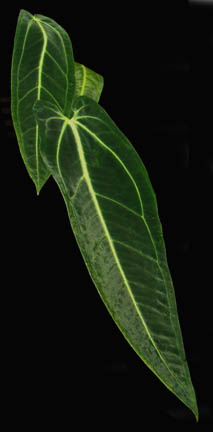 The ones that grow on trees are scientifically known as either
epiphytes or hemiepiphytes.
An epiphyte (ep-a-FIT) is a plant that
grows upon another plant, normally a tree. They grow
in the trees because the seed
berries eaten by a bird
or animal is then left on a
tree branch in the animal's droppings. Those seeds find just
enough nutrients in the droppings to germinate and
begin to grow.
The ones that grow on trees are scientifically known as either
epiphytes or hemiepiphytes.
An epiphyte (ep-a-FIT) is a plant that
grows upon another plant, normally a tree. They grow
in the trees because the seed
berries eaten by a bird
or animal is then left on a
tree branch in the animal's droppings. Those seeds find just
enough nutrients in the droppings to germinate and
begin to grow.
Hybrid and "test
tube" Anthurium.
Anthurium species are very popular as house plants. Almost anyone who goes on vacation to Hawaii is at least tempted to bring home an Anthurium. The vast majority of the plants grown in Hawaii are hybrid varieties and not species. Most are hybridized from a species known to science as Anthurium andreanum (see photo of hybrid form at the top of this page). That species is found in northwest Ecuador and western Colombia, but it is popular for hybrid 'house plants' since it produces a colorful spathe.
A hybridized plant is one that is created by taking the pollen of one species and applying it to the spadix of another species in order to produce a plant that is "improved" or better, at least in the opinion of the hybridizer. In fact, the cross may produce a plant that has larger leaves, larger inflorescences, and inflorescence colors not seen in nature. But that hybrid is no longer either species. Lots of hybridizers grow their plants the old fashioned way and are constantly crossing pollen between species or other hybrids that are not sterile. They then grow the seeds to produce their plants.
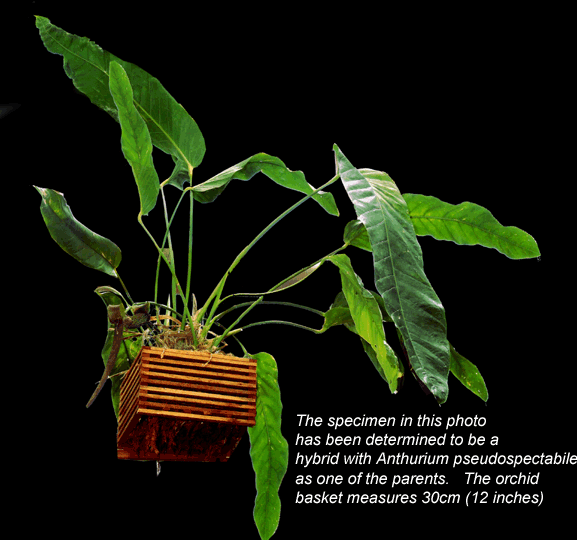 natural plant hormone and is used
in
larger than normal amounts in agriculture to stimulate both cell division and cell elongation that
affects the leaves as well as stems of a plant. The continued use
of the chemical in agriculture eventually affects fruit development. Since the
fruit of an aroid is produced on the spadix gibberellic acid is capable
of speeding
up the the production
of inflorescences.
In many cases the
Anthurium can become addicted to the chemical and once you
get it home the plant may produce far less inflorescences than
you expect. Since you have no GA3 to continue giving the
plant its "fix" it may not produce the colorful inflorescences
as often.
Gibberellic acid
has also been proven to produce badly formed spathes, double
spathes, strangely shaped leaves and other malformations.
For that reason alone the
plant needs near ideal conditions to keep it happy. One
caution. GA3 can have unwanted consequences including the
death of the plant and should not
be used by home growers in almost all cases. But if you've
wondered why your Anthurium no longer will produce an
inflorescence you may now know the reason.
natural plant hormone and is used
in
larger than normal amounts in agriculture to stimulate both cell division and cell elongation that
affects the leaves as well as stems of a plant. The continued use
of the chemical in agriculture eventually affects fruit development. Since the
fruit of an aroid is produced on the spadix gibberellic acid is capable
of speeding
up the the production
of inflorescences.
In many cases the
Anthurium can become addicted to the chemical and once you
get it home the plant may produce far less inflorescences than
you expect. Since you have no GA3 to continue giving the
plant its "fix" it may not produce the colorful inflorescences
as often.
Gibberellic acid
has also been proven to produce badly formed spathes, double
spathes, strangely shaped leaves and other malformations.
For that reason alone the
plant needs near ideal conditions to keep it happy. One
caution. GA3 can have unwanted consequences including the
death of the plant and should not
be used by home growers in almost all cases. But if you've
wondered why your Anthurium no longer will produce an
inflorescence you may now know the reason.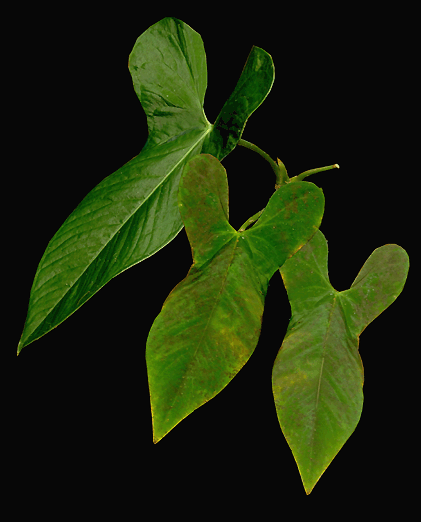 know nothing about Anthurium species and advice such as
allow it to dry out completely before watering again
or water it sparingly is bad
information. There are a few species that like to dry
between watering but those are not the common hybrids
found in retail stores! Any suggestion you use off the
shelf potting soil is also very bad information and is a guarantee
the sales person knows very little about Anthurium species.
know nothing about Anthurium species and advice such as
allow it to dry out completely before watering again
or water it sparingly is bad
information. There are a few species that like to dry
between watering but those are not the common hybrids
found in retail stores! Any suggestion you use off the
shelf potting soil is also very bad information and is a guarantee
the sales person knows very little about Anthurium species. The majority of Anthurium store bought plants are juvenile forms and look very little like the adult form of the species since Anthurium morph as they grow! During the 18th and 19th centuries botanists were confused by the incredible differences in adult forms and juvenile forms and often tried to give each of them a different scientific name. That is one reason some plants have more than one scientific name. Those multiple names are known as synonyms and can be the source of a great deal of confusion among collectors.
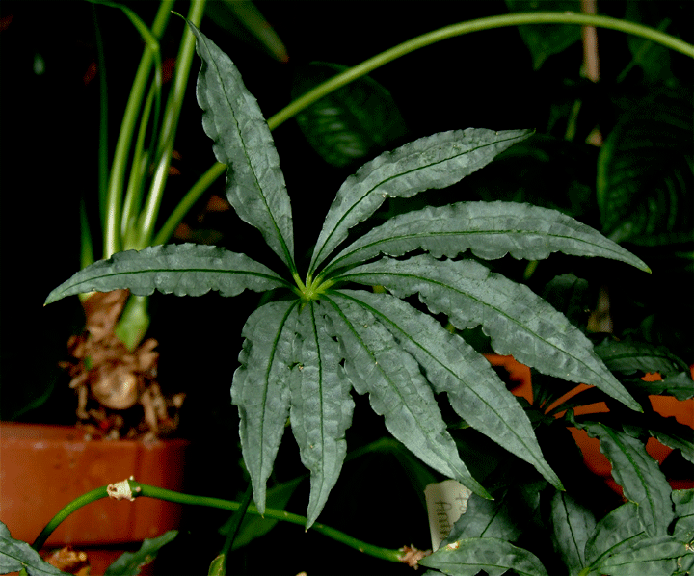 If you live in a tropical or semi-tropical climate you may be
able to
simply put your Anthurium in the ground. If
it is an epiphyte it may try to climb a tree. If it is a
terrestrial form, give it lots of room since many of the
"birds nest" species love to spread and can eventually grow
leaves 6 feet long! Otherwise proper potting of your
specimen is very important
if you want it to survive and
grow to reach its potential natural beauty.
If you live in a tropical or semi-tropical climate you may be
able to
simply put your Anthurium in the ground. If
it is an epiphyte it may try to climb a tree. If it is a
terrestrial form, give it lots of room since many of the
"birds nest" species love to spread and can eventually grow
leaves 6 feet long! Otherwise proper potting of your
specimen is very important
if you want it to survive and
grow to reach its potential natural beauty. 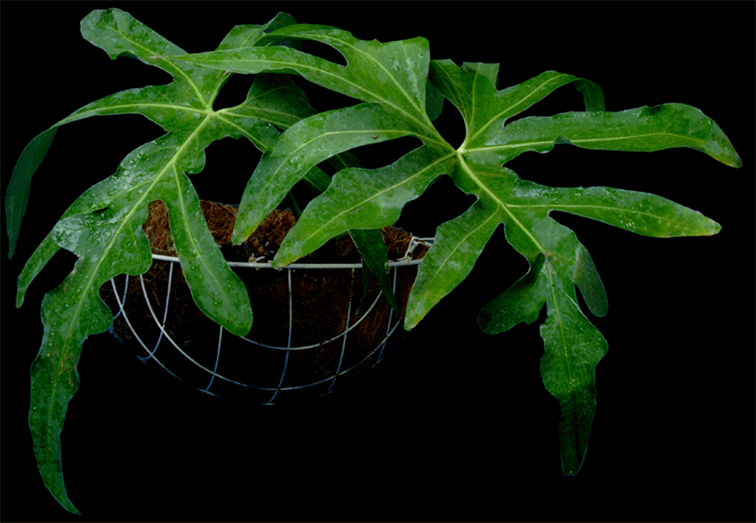 Some sellers provide
Anthurium attached
to volcanic rock. There are species known to be epipetric
that means they grow on stone.
Volcanic rock can work but you must keep those rocks constantly
damp. The plant will extract the
necessary water from the interior of the porous rock but that
does not mean to sit the plant in water. Just keep the
rocks wet. No Anthurium species is known to grow in
water despite what some websites and sellers try to make you
believe.
Some sellers provide
Anthurium attached
to volcanic rock. There are species known to be epipetric
that means they grow on stone.
Volcanic rock can work but you must keep those rocks constantly
damp. The plant will extract the
necessary water from the interior of the porous rock but that
does not mean to sit the plant in water. Just keep the
rocks wet. No Anthurium species is known to grow in
water despite what some websites and sellers try to make you
believe. 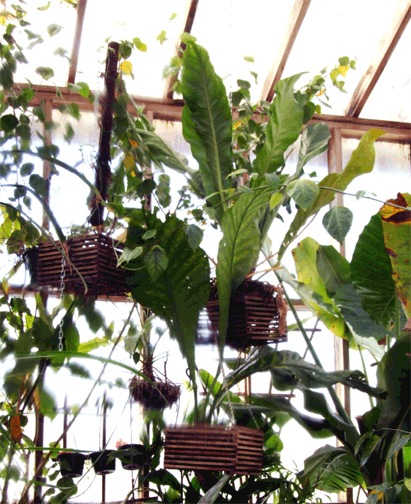 orchid basket packed with good quality
sphagnum moss. Since the plant normally lives in the top
or on the side of a tree it can adapt to those conditions and we
have a few plants growing on our epiphytic log with no soil at
all but you must keep the moss constantly damp.
In our atrium we water the plants displayed in this manner
almost daily! However, we often leave any soil attached to their
roots and do not remove it. We simply pack the moss around the
roots as well as mix the soil mixture we will describe with the
moss. We also cut the moss into very fine pieces. In a few months you
may begin to see
the roots extending down through the moss and hanging out the
bottom of the orchid basket that is very natural. At one
time one of our guests grabbed a pair of scissors and tried to
cut them all off because she thought they looked bad. I
nearly screamed since this is the way Anthurium plants grow in
the forest! You should know this method is tricky to use and
requires constant monitoring.
orchid basket packed with good quality
sphagnum moss. Since the plant normally lives in the top
or on the side of a tree it can adapt to those conditions and we
have a few plants growing on our epiphytic log with no soil at
all but you must keep the moss constantly damp.
In our atrium we water the plants displayed in this manner
almost daily! However, we often leave any soil attached to their
roots and do not remove it. We simply pack the moss around the
roots as well as mix the soil mixture we will describe with the
moss. We also cut the moss into very fine pieces. In a few months you
may begin to see
the roots extending down through the moss and hanging out the
bottom of the orchid basket that is very natural. At one
time one of our guests grabbed a pair of scissors and tried to
cut them all off because she thought they looked bad. I
nearly screamed since this is the way Anthurium plants grow in
the forest! You should know this method is tricky to use and
requires constant monitoring.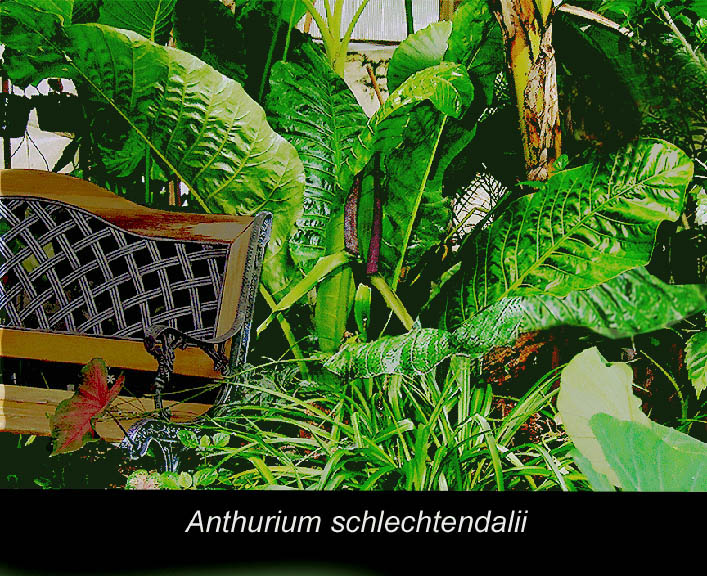 soil!
soil! Soil mixture.
Fermentation and saprophytes often occur in muddy soil that will not not allow the roots to breathe but they don't
necessarily occur in water and is why we can cause a plant that is about to die to grow new roots in a clean glass of water.
As a result, it is necessary to use soil mixes that allow the roots to breathe and will not remain soggy. I've attempted in
many threads to explain the necessity of mixing proper soil for plants but the advice is often ignored since it requires
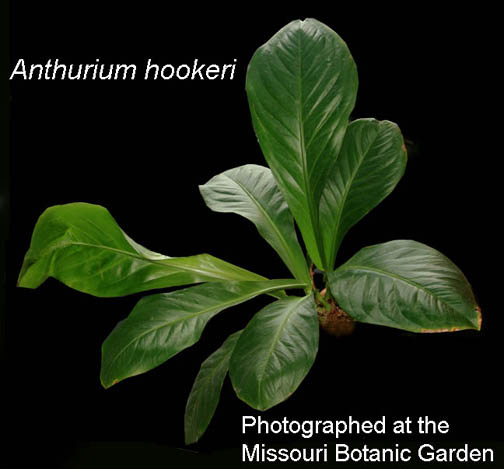 some "work" on the part of
the plant's keeper. The reason plants rot is not the
amount of water given to the plant! These are rain
forest plants and are literally drowned for months
at a time!
some "work" on the part of
the plant's keeper. The reason plants rot is not the
amount of water given to the plant! These are rain
forest plants and are literally drowned for months
at a time! If you could visit a rain forest you would quickly learn the soil is composed of leaf litter, decaying wood, compost and the charcoal left behind when a part of the forest burns. If we'll just listen to Mother Nature we can all make our plants grow as they should in nature. That is precisely what I attempt to explain when I recommend mixing soil, not just buying a bag at the store.
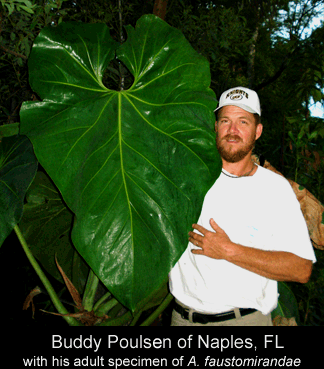 Although we mix our soil based on how
a species grows in
nature we primarily use a very loose soil mix with 30 % Miracle Grow Moisture Control Potting
Soil combined
with 20% high quality peat moss, 40% orchid potting media that
has hard wood,
charcoal and gravel mixed with 10% Perlite™ that is combined and
mixed thoroughly with a hand full or two of cedar mulch along
with finely cut spahgnum moss. The idea to
include charcoal is to increase drainage but also to
take advantage of the tiny air spaces in the
charcoal for growing beneficial microbes. It helps
with water retention, as well. If you have some good
compost feel free to add it. Small pieces of
charcoal can be purchased from any good orchid
supply.
Although we mix our soil based on how
a species grows in
nature we primarily use a very loose soil mix with 30 % Miracle Grow Moisture Control Potting
Soil combined
with 20% high quality peat moss, 40% orchid potting media that
has hard wood,
charcoal and gravel mixed with 10% Perlite™ that is combined and
mixed thoroughly with a hand full or two of cedar mulch along
with finely cut spahgnum moss. The idea to
include charcoal is to increase drainage but also to
take advantage of the tiny air spaces in the
charcoal for growing beneficial microbes. It helps
with water retention, as well. If you have some good
compost feel free to add it. Small pieces of
charcoal can be purchased from any good orchid
supply.Many growers call this type of mixture a "jungle mix" due to its similarity to the very loose soil in a rain forest. The peat, orchid medium, charcoal, mulch, sphagnum and Perlite™ hold moisture and release it back to the roots as needed. The other ingredients keep the soil loose and from becoming hard packed. The roots of the plant will easily move through he mix and will also attach to the bark just as they do in nature on the side of a tree. Depending on the species, we sometimes also add small pieces of crushed volcanic rock frequently sold in orchid supply stores.
I've had "nursery experts" write to say this soil mixture won't work due to the orchid potting media and mulch. They claim the bark and mulch will eventually rot and create air pockets in the soil and then kill the plant. They need to tell that to the experts at botanical gardens such as the Missouri Botanical Garden in St. Louis that maintains one of the world's largest collection of Anthurium since they developed the mixture. Botanical gardens in Florida, Europe and other parts of the United States us a similar mixture for almost all aroids. We've been using it since 2003 and our Anthurium as well as Philodendron species just keep growing!
Light intensity.
The next important consideration in Anthurium care is light. In almost any rain forest, light is a very precious commodity! Plants fight for position and large ones often deprive small specimens of any light at all! Anthurium and other species climb trees to reach the light! As they grow high on the side of the tree they morph into what often appears to be a totally different species! Although a few, mostly with velvet textured leaves, prefer lower light lmost
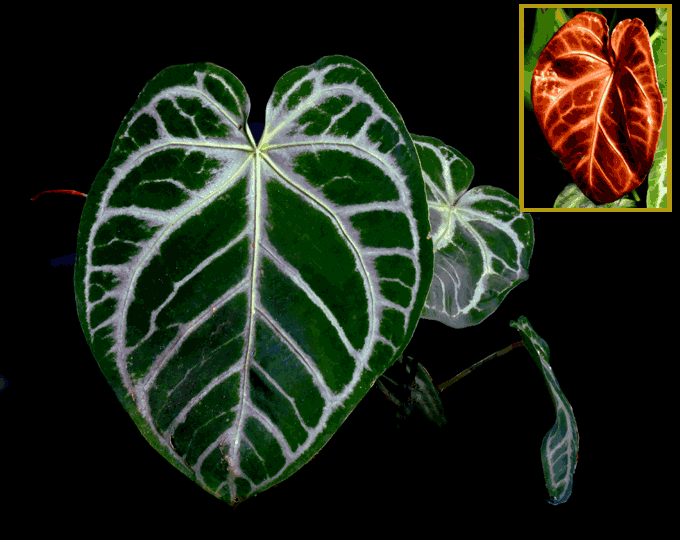 Anthurium prefer bright
indirect light. Some will exist in deep shade like your
living room but
will not flourish. Don't try to
grow your Anthurium in
a darkened corner, keep them near a
window with bright diffused light. Some can be
trained to live in extremely bright light but very few will survive
in direct sunlight. If you are growing your Anthurium species outdoors keep them close to a tree that
will allow them to have filtered sunlight.
Anthurium prefer bright
indirect light. Some will exist in deep shade like your
living room but
will not flourish. Don't try to
grow your Anthurium in
a darkened corner, keep them near a
window with bright diffused light. Some can be
trained to live in extremely bright light but very few will survive
in direct sunlight. If you are growing your Anthurium species outdoors keep them close to a tree that
will allow them to have filtered sunlight.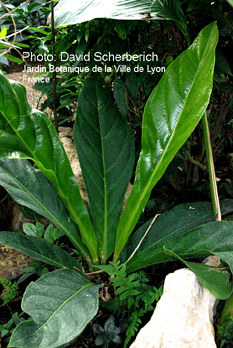 Watering is important to
the proper care of your Anthurium. In our
rain forest we sometimes water every other day of
the week but we
vary the water schedule to include more water in the heat of the summer
and less in winter. Some days
we find it necessary to
water twice daily. Our system has an automatic overhead misting system
that is
designed to duplicate a rain forest. Anthurium
species are rain forest plants and receive frequent watering
in their natural habitat. But do not over
water, just be sure and use a porous soil mix as described
above and keep the plant humid with misting from a spray bottle.
You can also place a tray of water beneath the pot
that will evaporate around the leaves to increase
the humidity in the immediate area.
Watering is important to
the proper care of your Anthurium. In our
rain forest we sometimes water every other day of
the week but we
vary the water schedule to include more water in the heat of the summer
and less in winter. Some days
we find it necessary to
water twice daily. Our system has an automatic overhead misting system
that is
designed to duplicate a rain forest. Anthurium
species are rain forest plants and receive frequent watering
in their natural habitat. But do not over
water, just be sure and use a porous soil mix as described
above and keep the plant humid with misting from a spray bottle.
You can also place a tray of water beneath the pot
that will evaporate around the leaves to increase
the humidity in the immediate area.In nature an Anthurium receives only natural forms of fertilizer since there is no one in the forest to go around with a big bottle and sprinkle it on everything! The epiphytic species can collect minerals in the rain that comes from the winds blowing across the Atlantic from Africa. Those winds often bring dust from major dust storms in the African plains to the rain forests of tropical America and once it settles in the rain the long dangling roots of the plants can gather a small amount of dissolved minerals and nutrients. They also gain fertilizer from decayed vegetation (leaves) that collects around their stems and roots but they receive nothing near the amount of fertilizer home growers are prone to give! Excess fertilizer can kill your plant so don't use more than the manufacturer recommends. In most cases use less! Less is much better than too much.
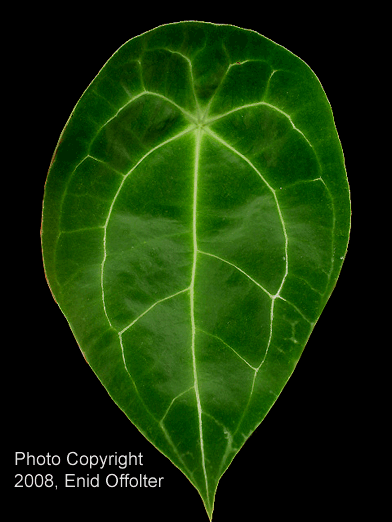 Regarding fertilizers, aroid
expert Julius Boos wrote,
"It is also the
epiphytic plants that benefit just as much from falling debris
and rain! Many 'birds-nest" type plants actually grow on trunks
and branches of trees. In French Guyana we saw a species
of Philodendron that grows like a vine up tree trunks, and when
it reaches a suitable spot, changes form from a climbing vine
and becomes a 'birds-nest', catching leaves. It then
creates an area where ants actually build their nest in the
roots and amongst the leaves/debris mix. These ants also provide
lots of fertilizer with their by-products, left-over insect and
fruit parts, etc.. The rain also washes debris and the nitrogen
it picks up and contains on to the long, pendent roots of other
species."
Species, such as the terrestrial "birds nest" forms are designed
to collect falling vegetation: leaves and other debris.
In nature, those species will often be found with piles of dead
leaves and other plant material inside their conical base.
That material then decays and the result is a natural form of
fertilizer for the plant, especially when insects are invited to
set up home. But most collector/growers carefully collect
and clean out all dead and decaying material found around their
plant! We are then depriving the plant of the natural form
of fertilizer for the sake of "beauty".
Regarding fertilizers, aroid
expert Julius Boos wrote,
"It is also the
epiphytic plants that benefit just as much from falling debris
and rain! Many 'birds-nest" type plants actually grow on trunks
and branches of trees. In French Guyana we saw a species
of Philodendron that grows like a vine up tree trunks, and when
it reaches a suitable spot, changes form from a climbing vine
and becomes a 'birds-nest', catching leaves. It then
creates an area where ants actually build their nest in the
roots and amongst the leaves/debris mix. These ants also provide
lots of fertilizer with their by-products, left-over insect and
fruit parts, etc.. The rain also washes debris and the nitrogen
it picks up and contains on to the long, pendent roots of other
species."
Species, such as the terrestrial "birds nest" forms are designed
to collect falling vegetation: leaves and other debris.
In nature, those species will often be found with piles of dead
leaves and other plant material inside their conical base.
That material then decays and the result is a natural form of
fertilizer for the plant, especially when insects are invited to
set up home. But most collector/growers carefully collect
and clean out all dead and decaying material found around their
plant! We are then depriving the plant of the natural form
of fertilizer for the sake of "beauty".All Anthurium species are tropical that means they can't tolerate really cold temperatures. Some do live high in the Andes Mountains well above the cloud line and are "cool" loving species. But they don't like cold! The cloud forest species do not like heat and won't do well in an outdoor setting where the temperature may stay above 26.6C (80 degrees F) for long periods of time. They can tolerate short spells of high temperatures, but some, such as Anthurium rugulosum, (photo left) may not survive. Many growers of these cool loving species use a high humidity "wet wall" combined with a small air conditioning system to keep the ambient temperature low and the humidity high. Many of
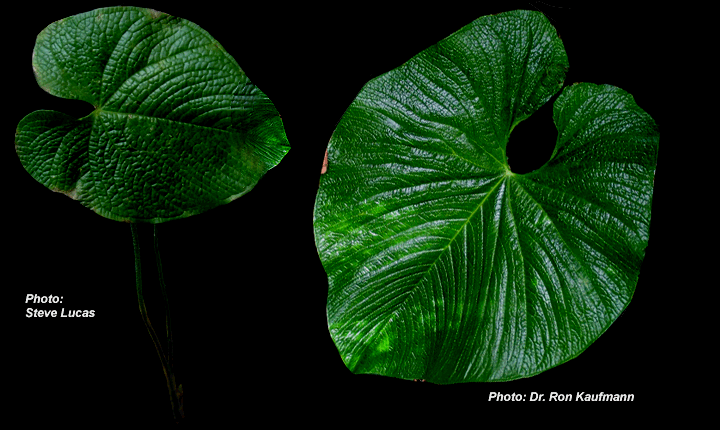 these species will do well down to 4.45C (40 degrees
Fahrenheit), but not much cooler.
these species will do well down to 4.45C (40 degrees
Fahrenheit), but not much cooler.Humidity, a little or a lot?
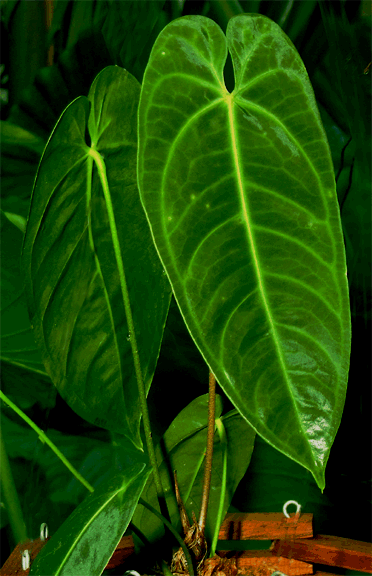 method to increase the humidity around your Anthurium. In our
artificial rain
forest the humidity is always 85% or higher due to the
waterfall and pond in the center of the room as well
as frequent watering! Some
growers keep their Anthurium species near a swimming
pool to allow for a constantly high humidity. Air
circulation is equally important since the air is almost always
moving in the rain forest. Avoid stagnant air since that
may encourage mold, fungus and insect predators.
method to increase the humidity around your Anthurium. In our
artificial rain
forest the humidity is always 85% or higher due to the
waterfall and pond in the center of the room as well
as frequent watering! Some
growers keep their Anthurium species near a swimming
pool to allow for a constantly high humidity. Air
circulation is equally important since the air is almost always
moving in the rain forest. Avoid stagnant air since that
may encourage mold, fungus and insect predators.If you can't give the species rain forest humidity conditions then there is a simple alternative. Place an attractive shallow dish filled with water beneath the plant's pot. Fill that pan with gravel, preferably one that does not have too much limestone. Fill the pan and gravel with water and then sit your plant and pot on top of this gravel bath in to create a micro-climate around the Anthurium. It works! Water will evaporate around the leaves and fool the plant into believing it is living in a humid rain forest environment. When you water the excess will simply drain into the gravel pot.
Why do you want to avoid limestone gravel? If you use the soil mixture we suggest, you've just created a soil mixture with a pH below 7, likely around 6.5. The Anthurium will appreciate that pH level! If you add limestone to the mix, the pH can be raised to above 7 and the Anthurium is not as likely to appreciate that level with the exception of a few species that do live in higher soil pH areas of the tropics.
All
aroids produce an inflorescence so the production of a spathe
and spadix alone does not prove the plant is an Anthurium.
Anthurium species have two unique features
that can easily be observed by a plant collector.
Those
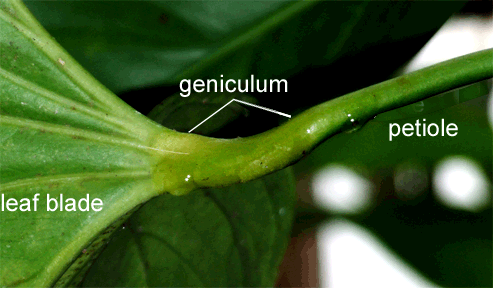 features are known as the geniculum and the collective
vein and both can be seen on any Anthurium specimen. The
geniculum is located at the top of the petiole that is the
stalk that supports each leaf. The geniculum allows the
leaf to rotate and orient itself in order to better collect sunlight.
The geniculum looks and works something like
your knee or elbow. Just like your elbow allows you to
bend and rotate your arm the geniculum allows the leaf of an Anthurium to rotate itself up, down or from side to side. The geniculum may be
swollen and obvious in many species but barely noticeable except
to the touch in others.
Aroid expert Julius Boos explains,
"the geniculum acts like a ''wrist'', and actually allows the
leaf blade to turn or rotate to align itself with the light
source and occurs only on some aroid genera including Anthurium
and Spathiphyllum but not on others."
features are known as the geniculum and the collective
vein and both can be seen on any Anthurium specimen. The
geniculum is located at the top of the petiole that is the
stalk that supports each leaf. The geniculum allows the
leaf to rotate and orient itself in order to better collect sunlight.
The geniculum looks and works something like
your knee or elbow. Just like your elbow allows you to
bend and rotate your arm the geniculum allows the leaf of an Anthurium to rotate itself up, down or from side to side. The geniculum may be
swollen and obvious in many species but barely noticeable except
to the touch in others.
Aroid expert Julius Boos explains,
"the geniculum acts like a ''wrist'', and actually allows the
leaf blade to turn or rotate to align itself with the light
source and occurs only on some aroid genera including Anthurium
and Spathiphyllum but not on others."
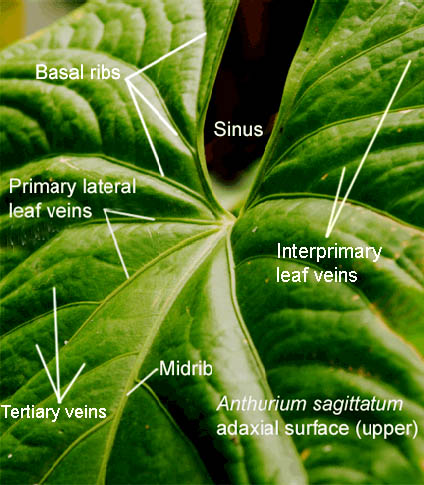 Any leaf contains several different vein forms. The
centralized rib vein is known as the mid rib and there are large veins
known as the basal ribs, primary lateral veins, interprimary
veins with the smaller known as the tertiary veins. The
tertiary veins are the repeatedly branched veins that arise
from and are connected to the primary lateral and
interprimary veins. The reticulate veins are the smallest
visible vein form found within small areas called areoles
(also a condition known as areolate). The primary lateral leaf veins
on any Anthurium connect into that collective vein.
The area between the leaf lobes is known as the sinus.
Any leaf contains several different vein forms. The
centralized rib vein is known as the mid rib and there are large veins
known as the basal ribs, primary lateral veins, interprimary
veins with the smaller known as the tertiary veins. The
tertiary veins are the repeatedly branched veins that arise
from and are connected to the primary lateral and
interprimary veins. The reticulate veins are the smallest
visible vein form found within small areas called areoles
(also a condition known as areolate). The primary lateral leaf veins
on any Anthurium connect into that collective vein.
The area between the leaf lobes is known as the sinus.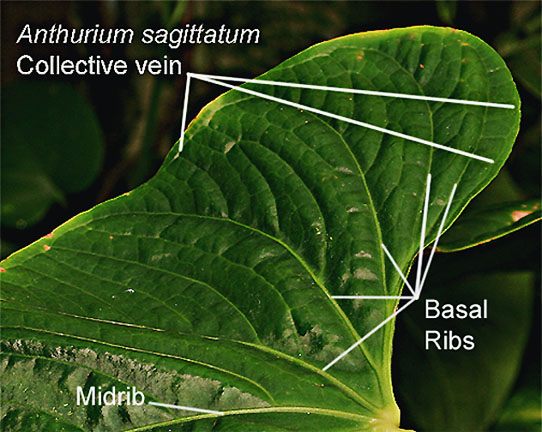 opposite
side to reconnect with a primary lateral leaf vein on the
opposite side as a continuation of a primary lateral leaf
vein. Collective veins may be observed in
Anthurium, Syngonium, Alocasia, Colocasia, Xanthosoma,
Arisaema, some Amorphophallus as well as other
genera.
opposite
side to reconnect with a primary lateral leaf vein on the
opposite side as a continuation of a primary lateral leaf
vein. Collective veins may be observed in
Anthurium, Syngonium, Alocasia, Colocasia, Xanthosoma,
Arisaema, some Amorphophallus as well as other
genera.What is the difference in a stem and a petiole?
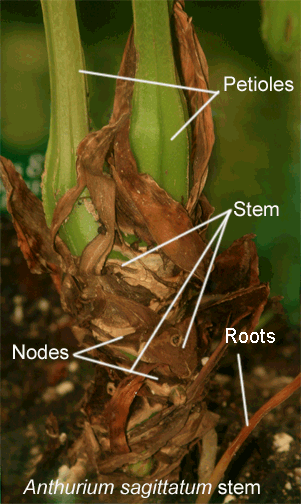 A
petiole is the support of the leaf and is also a part of the
leaf. The stem is the support for the entire plant. As you
have likely realized the petiole is what
most
people
often call a "stem" but that is an incorrect use of either term.
A
petiole is the support of the leaf and is also a part of the
leaf. The stem is the support for the entire plant. As you
have likely realized the petiole is what
most
people
often call a "stem" but that is an incorrect use of either term.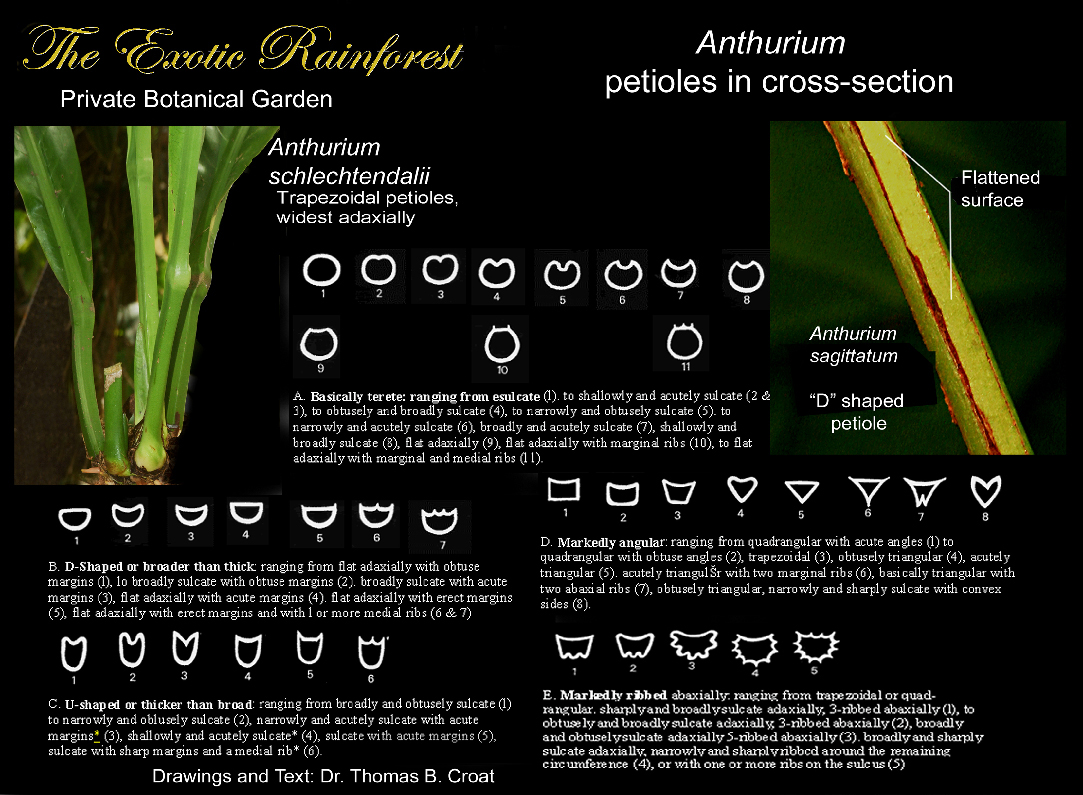
Natural variation in the shape of the plant.
If you plan on growing an Anthurium it is smart to first learn just how the species grows in nature (assuming it is a species) and then try to duplicate that condition as best possible. This is important if you wish to experience the natural beauty and full growth potential of the specimen. Although aroid species have a general "blade shape" in the adult form, that shape may change as a plant matures. One major problem with figuring out what species of Anthurium you are growing is caused by a phenomenon known as "variability". Anthurium species can have a variety of leaf shapes within a single species. Not all the leaves on a single plant will be identical in shape. Think of it as human beings all having different "faces". There is only one species of humans but humans have many "faces". An Anthurium species also has "faces" or growth forms that often makes the identification of a particular species complicated. As you can easily see from the few photos on this page an Anthurium has no set shape! You would like to understand how any plant can have a variety of leaf shapes you will find the answers in our article on Natural variation.
Tje drawings below are courtesy of Deni Bown.
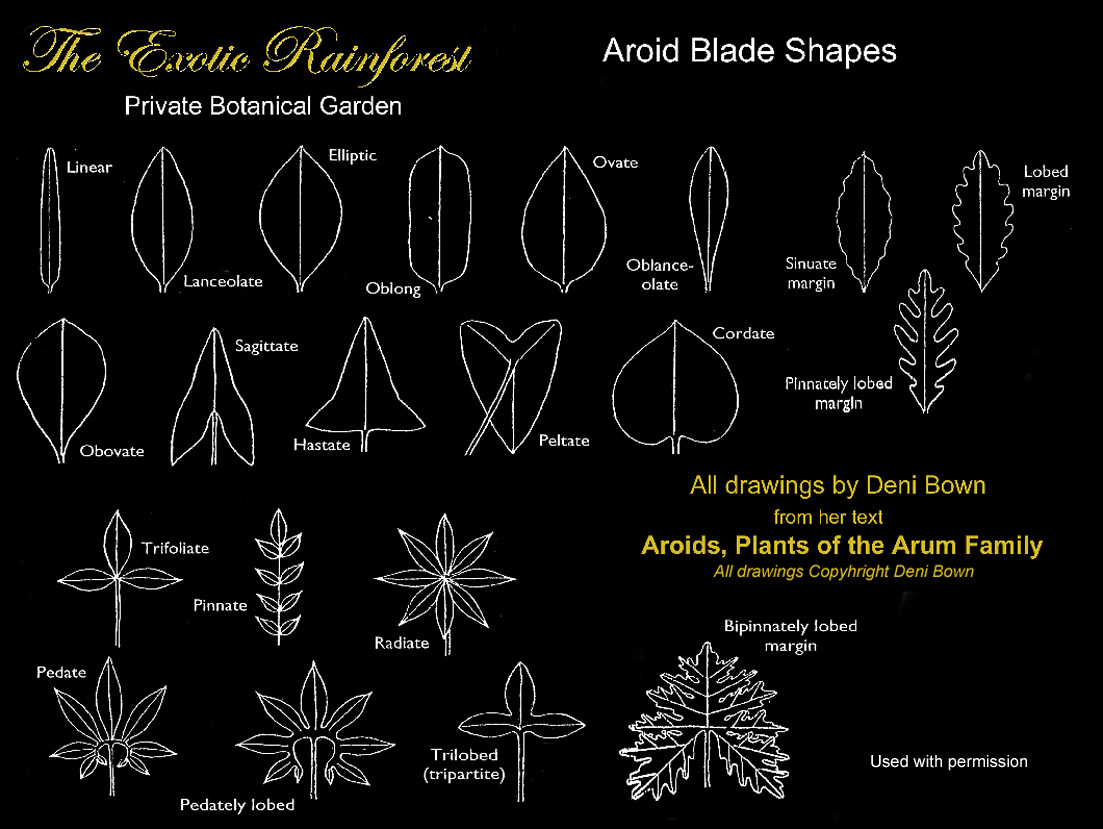
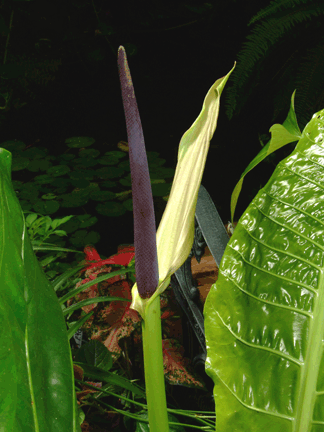 All Anthurium
species are members of the larger plant family known as
Araceae and are commonly known as aroids. An aroid is a plant that reproduces by producing an
inflorescence known to science as a spathe that is
only a
modified
leaf.
The inflorescence
that is sometimes shaped like a hood or cupped hands is made up of
several parts.
The portion that appears to be a
"flower" or hood is the spathe and inside is the spadix
that
somewhat resembles an elongated pine cone. The spadix is a
spike on a thickened fleshy axis that can produce tiny flowers
if the plant is not sterile.
All Anthurium
species are members of the larger plant family known as
Araceae and are commonly known as aroids. An aroid is a plant that reproduces by producing an
inflorescence known to science as a spathe that is
only a
modified
leaf.
The inflorescence
that is sometimes shaped like a hood or cupped hands is made up of
several parts.
The portion that appears to be a
"flower" or hood is the spathe and inside is the spadix
that
somewhat resembles an elongated pine cone. The spadix is a
spike on a thickened fleshy axis that can produce tiny flowers
if the plant is not sterile.
natural and artificial pollination
Growing Anthurium from seed.
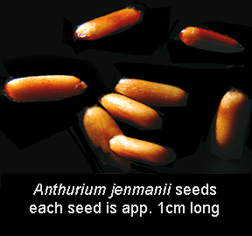 Should you plan to grow your
own Anthurium seeds do not pot them in soil!
Instead, gently squeeze the seeds out of the mesocarp pulp of
the berry into a jar with clear sterile water and shake the capped jar well to separate the pulp from
the seeds. In a couple of days the seeds will settle to the
bottom and the pulp will rise to the surface so it can be
removed. Remove the seeds and put them in a clean jar of
water and shake once more to remove any traces of the pulp that
can cause the seeds to produce a fungus. Prepare a shallow
plastic container (such as a restaurant salad container) by
cutting long strand sphagnum moss into very fine pieces and mix in
approximately 1/4 aquarium charcoal. Press this fine mix into
the bottom of the container but do not add any soil! Be sure
to punch drain holes
in the container's bottom before filling and do not allow the
container to hold water!
Should you plan to grow your
own Anthurium seeds do not pot them in soil!
Instead, gently squeeze the seeds out of the mesocarp pulp of
the berry into a jar with clear sterile water and shake the capped jar well to separate the pulp from
the seeds. In a couple of days the seeds will settle to the
bottom and the pulp will rise to the surface so it can be
removed. Remove the seeds and put them in a clean jar of
water and shake once more to remove any traces of the pulp that
can cause the seeds to produce a fungus. Prepare a shallow
plastic container (such as a restaurant salad container) by
cutting long strand sphagnum moss into very fine pieces and mix in
approximately 1/4 aquarium charcoal. Press this fine mix into
the bottom of the container but do not add any soil! Be sure
to punch drain holes
in the container's bottom before filling and do not allow the
container to hold water!
One important goal is to have a high humidity environment in which the seeds can germinate. You need no more than 1/3 of the container to be filled with the moss growing bed that will now be similar to the floor of a rain forest. Spread your evenly spaced seeds across the surface and mist them lightly with either rain water or bottled purified water. Do not attempt to cover or bury the seeds! Put on the lid of the container and you now have a miniature greenhouse. Store the seeds in moderately filtered light in a warm room and in two days to a week you will see germination. Mist them only as needed.
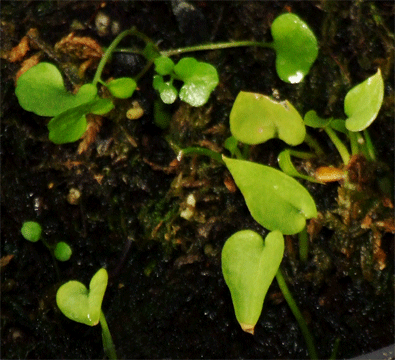 Continue to grow the
plants with the lid on and just mist them lightly
until they are well developed and then transplant them to fast
draining soil that contains peat moss, shredded sphagnum moss,
hard wood charcoal (such as aquarium charcoal) and high quality
potting soil in roughly an equal mixture. In a year or two you'll have
nice specimens to
display or give away.
Continue to grow the
plants with the lid on and just mist them lightly
until they are well developed and then transplant them to fast
draining soil that contains peat moss, shredded sphagnum moss,
hard wood charcoal (such as aquarium charcoal) and high quality
potting soil in roughly an equal mixture. In a year or two you'll have
nice specimens to
display or give away.
Anthurium plants are not difficult to grow!
Growing and the care of Anthurium species is not difficult. Only a few are hard to grow, and most will grow fairly well under less than ideal conditions. The keys are allowing the epiphytic forms to climb, giving the spreading types room to spread, fast draining soil that stays damp, a stable temperature, good air circulation, and good light that is relatively bright. It's just that easy!
Although this article is a brief introduction to Anthurium species there is far more to learn! We strongly recommend you consider joining the International Aroid Society in order to learn even more. Through the IAS discussion forum Aroid l you can ask questions to many of the world's top Anthurium experts and be assured of a qualified answer. You'll also receive an annual copy of the IAS journal Aroideana which is highly respected in the scientific community as well as four quarterly newsletters.
Annual membership is only
$25.00 per year in the United States, slightly higher elsewhere to
cover postage!
Curator, The Exotic Rainforest
Steve@ExoticRainforest.com
S
Click the links below for
information:
For even more
information, join the
International Aroid Society:
http://www.exoticrainforest.com/Join%20IAS.html 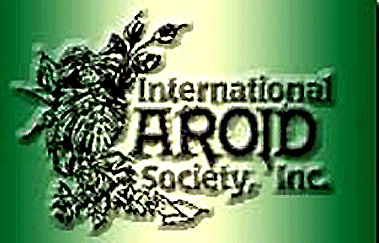
Want to know more about the pollination of aroids? Read Julius Boos' article here: http://www.exoticrainforest.com/Natural%20and%20artificial%20pollination%20in%20aroids.html
Incredible aroid botanical
photographs by botanist David Scherberich
http://www.aroidpictures.fr/pictures.html
Concerned about calcium oxalate crystals? Have you been convinced they
are a "deadly poison"?
Specimens may be available from
Brian's Botanicals
http://www.briansbotanicals.net/
For additional information from botanists, competent researchers and growers, join the International Aroid Society: http://www.exoticrainforest.com/Join%20IAS.html
Concerned about calcium oxalate crystals? Have you been
convinced they are a "deadly poison"?
|
antorium
|
